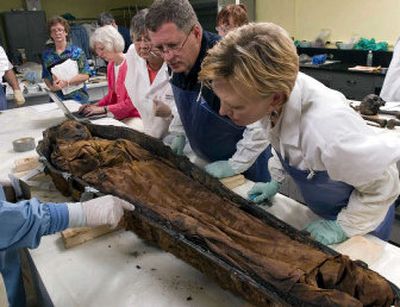Scientists study boy found in 1850 coffin

WASHINGTON – The mysterious boy on the Smithsonian laboratory table had probably died of pneumonia about 1850 – too sick to eat and delirious from fever.
His body had been dressed in a pleated shirt, finely tailored waistcoat and white sateen trousers, and buried in an elegant iron coffin along Columbia Road NW in the District of Columbia.
His remains were amazingly well preserved: He was 5 feet tall, dark haired and looked about 13. Beyond that, almost nothing was known. Who was he? Where had he lived? Why was he buried near a college in what was then the farm country well outside town?
This month, a team of experts at the National Museum of Natural History peered into his coffin to try to unravel his story, perhaps learn more about his death and maybe something of his life.
The mystery began April 1 when his coffin was discovered by construction workers digging beneath a gas line in Washington D.C.’s Columbia Heights neighborhood. The workers, unsure what to do, locked the coffin in an empty building where, on April 4, vandals broke in and smashed the coffin’s glass faceplate and metal cover.
It was subsequently turned over to the Museum of Natural History, where a team of forensic anthropologists, pathologists, historical archaeologists, clothing experts and researchers began its work.
The coffin, which had been stored in a cooler, was opened Aug. 3. The boy’s clothes were removed. An autopsy on the body was performed, and samples from his organs and strands of his hair were taken for further analysis.
Experts marveled at the preservation. The body’s darkened flesh was still supple, they said, and the facial features were mostly intact. The coffin appears to have been sealed until the vandalism, but it’s not entirely clear how that might have protected the body.
“We’re still working on the exact reason these remains are so well preserved,” said Larry Cartmell, an Oklahoma pathologist and expert on ancient diseases who helped perform the autopsy. “I don’t think we have that mystery solved yet.”